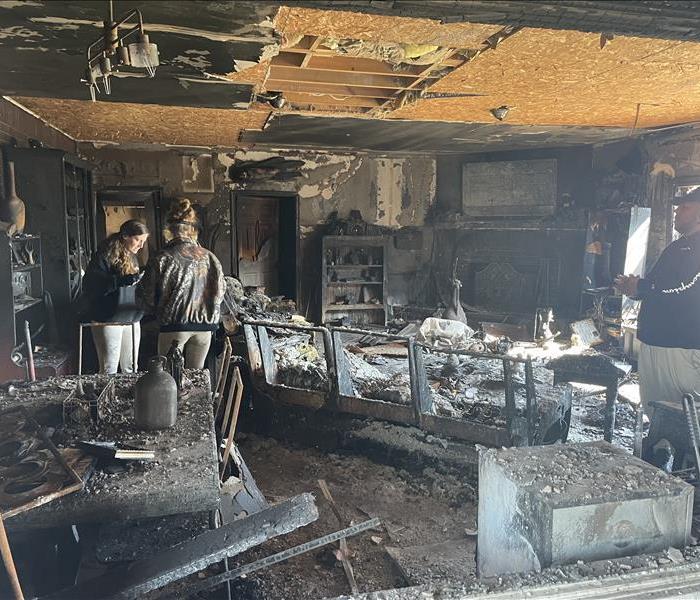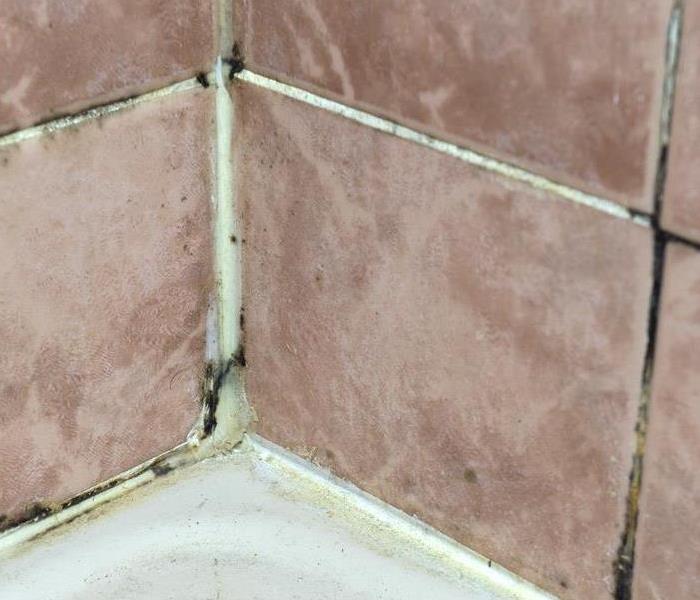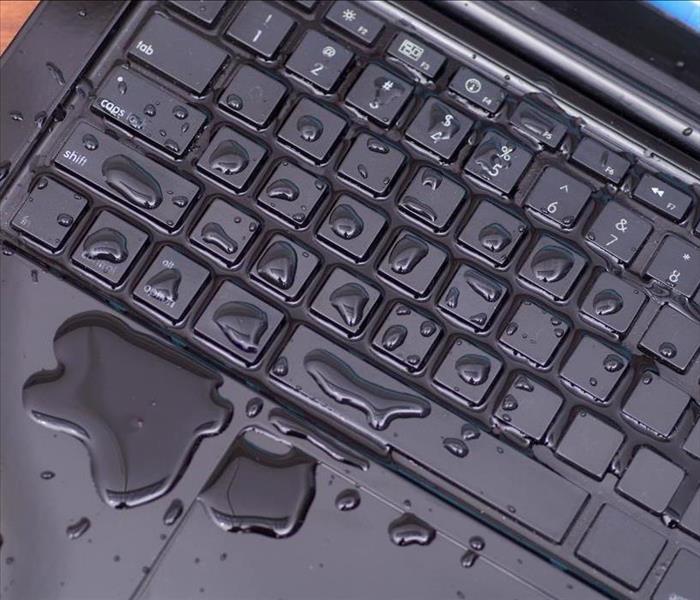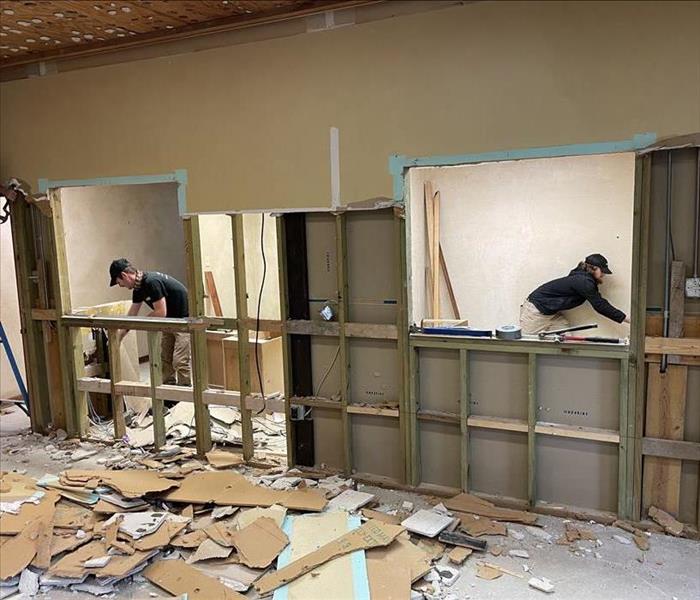Recent Posts
Winter Storm Damage Restoration for Homes in South Baton Rouge
1/14/2025 (Permalink)
Winter storms can wreak havoc on residential properties, causing unexpected challenges like roof damage, water intrusion, and burst pipes. If your home in South Baton Rouge has been impacted by severe winter weather, SERVPRO of South Baton Rouge is here to help with expert winter storm damage restoration services.
Our restoration process starts with a detailed assessment of the damage, allowing us to develop a tailored plan for your property. From water removal and structural drying to repairing storm-related damage, our team uses advanced equipment and proven techniques to ensure a thorough recovery. We also focus on preventing long-term issues like mold growth, which can result from lingering moisture.
SERVPRO of South Baton Rouge understands how stressful property damage can be, especially during the winter months. That’s why we’re available 24/7, ready to respond quickly and minimize disruption to your home and life. Our goal is to restore your property to its pre-damage condition as efficiently and effectively as possible.
Don’t let winter storm damage compromise the safety and comfort of your home. Whether it’s frozen pipes, flooding, or other storm-related issues, you can trust us for reliable and professional restoration services. Contact us today to make the damage “Like it never even happened.”
Storm Water Damage Restoration by SERVPRO of South Baton Rouge
1/7/2025 (Permalink)
Severe storms can cause significant water damage to your property, leaving behind flooding, leaks, and moisture buildup. SERVPRO of South Baton Rouge specializes in storm water damage restoration, offering fast and reliable services to protect your home from further damage.
When storms strike, it's crucial to act quickly to prevent mold growth and structural issues. Our expert team provides comprehensive storm water damage restoration, including water extraction, drying, and cleanup, ensuring your property is restored to its original condition.
SERVPRO of South Baton Rouge is available 24/7 for emergency storm damage restoration services. Our professional technicians are trained to handle storm-related water damage, providing peace of mind during stressful situations.
Don’t let storm damage ruin your home—contact us today for fast, efficient storm water damage restoration!
Mold Damage and Professional Cleaning in South Baton Rouge
10/30/2024 (Permalink)
Mold growth can be a serious issue for homes and businesses in South Baton Rouge, especially with the area’s humid climate. Mold damage not only affects property aesthetics but also poses potential health risks, especially for individuals with allergies or respiratory issues.
SERVPRO of South Baton Rouge specializes in professional mold cleaning to ensure your space is safe and healthy. Our process begins with a thorough inspection to pinpoint mold-prone areas, followed by effective containment to prevent further spread of mold spores. Using advanced remediation techniques, we eliminate mold from surfaces and treat the environment to prevent regrowth.
DIY mold removal often leaves behind spores, risking a quick return. Our certified professionals use specialized equipment and solutions to achieve complete mold removal, restoring your property to a safe, mold-free state.
For effective mold damage cleaning in South Baton Rouge, to restore your property and peace of mind. Reach out to our expert team today.
Contact: (225) 761-9500
Water Damage Restoration and Cleaning in South Baton Rouge
10/30/2024 (Permalink)
Water damage can quickly impact your home or business, causing structural issues, mold growth, and damage to belongings. In South Baton Rouge, where storms and plumbing leaks are common, SERVPRO of South Baton Rouge is here to provide expert water damage restoration services.
Our team responds swiftly to minimize the effects of water damage. We start with a thorough inspection and use advanced equipment for water extraction, drying, and dehumidification. Hidden moisture can lead to mold, so we ensure all affected areas are thoroughly dried and sanitized to prevent further issues.
Attempting to manage water damage alone can result in lingering moisture and future complications. Our professionals are trained to handle any size disaster, restoring your property to its pre-damage condition safely and efficiently.
For reliable water damage cleaning in South Baton Rouge, to restore your property and peace of mind. We’re here 24/7 to help protect your space from water damage.
Contact: (225) 761-9500
Maintaining a Safe and Clean Workspace in South Baton Rouge
7/26/2024 (Permalink)
A clean and safe workspace is essential for any business. Here are some tips to maintain it:
- Regular Cleaning: Schedule routine cleaning to keep the workspace hygienic.
- Safety Protocols: Implement and enforce safety protocols to prevent accidents.
- Pest Control: Keep pests at bay with regular inspections and treatments.
- Professional Services: Hire professional cleaning services for thorough sanitation.
SERVPRO of South Baton Rouge offers comprehensive commercial cleaning services to keep your business in top shape.
Mold Remediation After Storms and Flooding: Protecting Your Home
1/4/2024 (Permalink)
Storms and flooding can wreak havoc on our homes, leaving behind not only visible damage but also unseen threats. One of the most common and potentially dangerous consequences of water damage is mold growth. When left unattended, mold can cause various issues and structural damage. In this blog, we will explore the importance of mold remediation after storms and flooding, and how taking swift action can protect your home and safeguard your health.
Understanding the Risks of Mold After Storms and Flooding
- Explaining how excess moisture from storms and flooding creates an ideal environment for mold growth.
- Discussing the various types of mold commonly found after water damage and their potential health implications.
- Highlighting the importance of early detection and addressing mold issues promptly to prevent further damage.
The Dangers of Mold to your home
- Discussing how mold can weaken the structural integrity of your home and compromise its value.
- Emphasizing the importance of addressing mold growth to preserve the integrity of your living space.
Professional Mold Remediation Services
- Exploring the expertise and specialized equipment that professional mold remediation companies bring to the process.
- Discussing how experienced professionals can accurately assess the extent of the mold problem and develop a comprehensive remediation plan.
- Highlighting the benefits of hiring professionals, including their knowledge of effective mold removal techniques and their ability to minimize the likelihood of mold recurrence.
Steps in Mold Remediation After Storms and Flooding
Outlining the key steps involved in the mold remediation process, such as containment, air filtration, removal of affected materials, and thorough cleaning. Explain the importance of addressing the underlying cause of the mold growth, such as water intrusion or excessive moisture, to prevent future issues. Educate homeowners on the significance of proper disposal of mold-infested materials in a safe and regulated manner.
Preventive Measures to Avoid Future Mold Growth
- Providing practical tips to reduce the risk of mold growth in the future, such as maintaining proper ventilation, monitoring indoor humidity levels, and promptly addressing water leaks or damage.
- Highlighting the role of professional inspections and regular maintenance in detecting any potential mold issues before they escalate.
- Encouraging homeowners to be proactive in taking preventive measures to ensure a mold-free environment and protect their homes.
Mold growth after storms and flooding can be a significant concern for homeowners, but with prompt and professional mold remediation, the risks can be minimized. By understanding the dangers of mold to your home, and by enlisting the services of experienced professionals, such as SERVPRO of South Baton Rouge, you can safeguard your property and create a healthier living environment. Don't underestimate the importance of mold remediation after storms and flooding – take action today to protect your home and the well-being of your loved ones.
How to Remove Soot and Smoke Residue from Surfaces
12/18/2023 (Permalink)
 If you are unsure or dealing with extensive fire damage, it is recommended to consult with professional fire damage restoration experts.
If you are unsure or dealing with extensive fire damage, it is recommended to consult with professional fire damage restoration experts.
After a fire, one of the most challenging tasks of fire damage restoration is removing soot and smoke residue from surfaces. Soot and smoke particles can cling to various materials and surfaces, causing discoloration, odors, and secondary risks, if not properly addressed. In this blog, we will explore effective techniques for removing soot and smoke residue from surfaces, ensuring a thorough and successful fire damage restoration process.
Safety First
Before beginning any cleaning process, it is essential to prioritize safety. Wear protective gear such as gloves, goggles, and a respirator to protect yourself from potential health hazards. Open windows or use fans to provide adequate ventilation during the cleaning process.
Dry Cleaning
Dry cleaning methods are suitable for light or loose soot and can be used on surfaces that are delicate or prone to water damage. Start by vacuuming any loose soot particles with a vacuum cleaner equipped with a HEPA filter. Use a dry sponge or dry cleaning sponge to gently wipe away the remaining soot residue. Be careful not to apply excessive pressure, as it can push the soot deeper into the surface.
Wet Cleaning
Wet cleaning is appropriate for surfaces that can withstand moisture. Begin by testing a small, inconspicuous area to ensure that the cleaning solution does not cause discoloration or damage to the surface. Prepare a cleaning solution by mixing warm water with a mild detergent. Dip a sponge or cloth into the solution, wring out excess moisture, and gently wipe the soot-covered surface. Rinse the sponge or cloth frequently and change the cleaning solution as needed. Finally, use a clean, damp cloth to remove any remaining residue and allow the surface to dry thoroughly.
Professional Cleaning Products
There are various cleaning products available specifically designed for removing soot and smoke residue. Look for products that are suitable for the specific surface you are cleaning, such as upholstery, walls, or countertops. Follow the manufacturer's instructions carefully, and make sure to test the product in an inconspicuous area before applying it to larger surfaces.
Homemade Cleaning Solutions
If you prefer to use natural or homemade cleaning solutions, consider using vinegar or baking soda. Vinegar is acidic and can help break down soot and smoke residue. Mix equal parts of vinegar and water, apply the solution to the affected surface, and gently scrub with a soft cloth or sponge. Baking soda is an excellent deodorizer and can be used to neutralize odors. Create a paste by mixing baking soda with water, apply it to the soot-covered surface, and scrub gently.
Don't Forget Ventilation Systems
Soot and smoke residue can also accumulate in ventilation systems, contributing to lingering odors and potential recontamination. It is crucial to thoroughly clean and inspect air ducts, HVAC systems, and filters. Consider hiring professional duct cleaning services to ensure a comprehensive cleaning and restoration of these systems.
In conclusion, the removal of soot and smoke residue from surfaces requires careful consideration and effective techniques. Whether using dry or wet cleaning methods, professional cleaning products, or homemade solutions, it is essential to prioritize safety and test small areas before tackling larger surfaces. Remember to pay attention to ventilation systems to prevent recontamination and promote clean, fresh indoor air. If you are unsure or dealing with extensive fire damage, it is recommended to consult with professional fire damage restoration services who have the expertise and tools to effectively remove soot and smoke residue from surfaces, ensuring a thorough and successful restoration process.
Cleaning Tips: How to Get Rid of Mold in Your Shower
10/26/2023 (Permalink)
 Cleaning your shower periodically to reduce mold and mildew damage.
Cleaning your shower periodically to reduce mold and mildew damage.
Dealing with mold in your shower can be a frustrating and unsightly problem. However, with the right approach and cleaning techniques, you can effectively eliminate mold and prevent its recurrence. In this blog, we will share some helpful tips on how to get rid of mold in your shower without addressing any health concerns or risks associated with mold exposure.
Gather the Necessary Supplies
Before starting the cleaning process, gather the essential supplies. You will need gloves, a mask, a scrub brush or sponge, a cleaning agent (such as vinegar, hydrogen peroxide, or a mold-specific cleaner), and hot water. Ensure the area is well-ventilated by opening a window or turning on a bathroom fan.
Remove Surface Mold
Start by removing any loose mold on the surface of your shower tiles or grout. Thoroughly scrub the affected areas with a brush or sponge. If using a cleaning agent, follow the instructions on the product label and apply it to the mold-infested surfaces. Rinse the area with hot water and allow it to dry completely.
Deep Clean the Grout
To tackle mold in grout lines, create a paste using baking soda and water. Apply the paste to the grout and scrub it using a toothbrush or small brush. This will help eliminate mold embedded in the porous grout. Rinse the grout lines thoroughly with hot water and wipe away any excess paste or residue.
Prevent Future Growth
To prevent mold from returning, it's essential to keep your shower clean and dry. After each use, wipe down the walls and tiles with a squeegee or towel to remove excess moisture. Periodically inspect the shower for any signs of mold and address the issue promptly to prevent it from spreading.
Regular Maintenance
Maintaining a clean shower is key to preventing mold growth in the long run. Regularly clean your shower using mildew-resistant cleaners to minimize mold and mildew buildup. Additionally, consider applying grout sealant periodically to create a protective barrier against moisture and mold.
Eliminating mold in your shower is manageable with the proper cleaning techniques. By following these tips, you can effectively tackle mold growth and maintain a clean and mold-free shower. Remember to prioritize regular maintenance and keep the shower area dry to prevent mold from reappearing in the future. In some cases, despite your best efforts, mold in the shower may persist or reoccur. If you find that the mold problem is extensive or difficult to remove on your own, it may be necessary to seek professional assistance. Professional mold remediation services have the expertise and specialized equipment to handle severe mold infestations safely and effectively. Remember to address mold issues promptly to ensure a clean and healthy shower environment for you and your family.
Tips to Protecting Your Remote-Based Business
10/17/2023 (Permalink)
 In this blog we provide some steps you can take to prepare for water damage and mitigate its impact on your work-from-home business.
In this blog we provide some steps you can take to prepare for water damage and mitigate its impact on your work-from-home business.
As the number of work-from-home businesses continues to grow, it's important to consider water damage preparedness. Water damage can cause significant disruption to a home-based business, resulting in property damage, loss of inventory, and loss of income. In this blog post, we will discuss some steps you can take to prepare for water damage and mitigate its impact on your home-based business.
Conduct Regular Risk Assessment
One of the first steps in water damage preparedness is to identify the risks that may affect your business. Conducting a risk assessment can help you identify potential sources of water damage, such as leaking pipes, poor drainage, and natural disasters. Make a list of these risks and prioritize them based on their likelihood and potential impact.
Regularly Inspect Your Property
Regular property inspections can help detect issues early, reducing the risk of significant water damage. Inspect your property regularly for signs of water damage, such as leaks, water stains, and mold growth. Address any issues promptly to prevent further damage.
Back up all your important business documents, files, and data regularly. This will reduce the risk of losing valuable information in case of water damage. Use cloud-based storage or an external hard drive to store your important files.
Consider Business Interruption Insurance
Business interruption insurance can help cover the loss of income and expenses suffered due to water damage. Consider purchasing this insurance to protect your business in case of significant damage.
Create a Water Damage Emergency Plan
Develop a plan of action to follow in case of water damage. This plan should include steps to take in case of an emergency, contact information for emergency responders, and a plan for evacuating important equipment and inventory.
Investing in flood preparedness equipment such as sandbags, flood barriers, and sump pumps can help minimize the impact of water damage. Determine which equipment will best suit your business's needs and ensure it is readily available.
Contact Professional Water Damage Restoration Services
In case of significant water damage, it's crucial to contact professional water damage restoration services. They have specialized equipment and expertise to assess the damage, mitigate further damage, and restore your property promptly.
In conclusion, water damage can cause significant disruption to work-from-home businesses, but with preparedness and proactive measures, you can protect your business from potential financial losses and significant damages. Conducting regular assessments, and inspections, and investing in flood preparedness equipment can minimize the risk of water damage. Always keep in mind that prompt response and professional help in case of significant water damage can help mitigate further damage and save your business.
Battling Mold After A Storm
9/16/2023 (Permalink)
 Mold growth is a common issue following water damage.
Mold growth is a common issue following water damage.
When the skies clear after a storm or flooding in Baton Rouge, the immediate concerns may seem to fade away. However, the aftermath often leaves a hidden threat that can affect your home: mold. Mold growth is a common issue following water damage, and it's crucial for Baton Rouge homeowners to understand the risks and take proactive steps to address mold remediation. In this guide, we'll walk you through the process of mold remediation after storms and flooding, helping you safeguard your property and restore a healthy living environment.
Recognizing the Signs of Mold Infestation
Mold is a type of fungus that thrives in damp, humid environments. After a storm or flooding, your Baton Rouge home could become a breeding ground for mold if not properly addressed. Keep an eye out for the following signs that indicate mold may be present:
Musty Odor: A strong, musty smell is often a clear indication of mold growth. If you notice an unusual odor, investigate further.
Visible Mold: Mold can appear as discolored patches on walls, ceilings, and other surfaces. Pay close attention to areas that were exposed to water during the storm.
Act Quickly: The Importance of Timely Mold Remediation
Addressing mold growth promptly is essential to prevent it from spreading and causing further damage. Mold spores can spread through the air and settle in other areas of your home, exacerbating the problem. Swift action is crucial to minimize the extent of the infestation.
DIY vs. Professional Mold Remediation
While minor mold issues can sometimes be addressed with DIY methods, larger infestations require professional intervention. In Baton Rouge, where humidity levels are often high, it's best to consult a certified mold remediation specialist who understands the local climate and mold behavior. Professionals have the expertise, equipment, and protective gear needed to safely remove mold and prevent its return.
The Mold Remediation Process
A comprehensive mold remediation process typically includes the following steps:
Assessment: A mold remediation expert will assess the extent of the infestation and identify the source of moisture that led to its growth.
Containment: To prevent mold spores from spreading to unaffected areas, the contaminated area is sealed off using specialized barriers and negative air pressure.
Removal: Affected materials, such as drywall and insulation, are safely removed and disposed of. This step may involve HEPA vacuuming and thorough cleaning.
Dehumidification: Drying the affected area is crucial to prevent future mold growth. Dehumidifiers and proper ventilation help reduce moisture levels.
Prevention: Mold thrives in damp environments, so controlling humidity levels is key to preventing future infestations. Proper ventilation and sealing leaks will help keep mold at bay.
Tips for Preventing Future Mold Growth
After the mold has been successfully remediated, it's important to take steps to prevent its return:
Monitor Humidity: Use a hygrometer to measure indoor humidity levels and keep them between 30-50%. Consider using dehumidifiers in areas prone to moisture.
Prompt Repairs: Address any leaks or water damage promptly to prevent mold-friendly conditions from developing.
Proper Ventilation: Ensure proper ventilation in high-moisture areas such as bathrooms, kitchens, and basements.
Regular Inspections: Conduct routine inspections to catch any potential mold issues early before they become major problems.
Landscaping and Grading: Properly direct rainwater away from your home's foundation by maintaining proper landscaping and grading.
Mold remediation after storms and flooding is a critical aspect of maintaining a safe home environment in Baton Rouge. By understanding the signs of mold infestation, acting swiftly, and enlisting the help of professionals when necessary, you can effectively combat mold growth and protect your property. Remember, prevention is key, so implement the recommended tips to ensure your home remains mold-free for years to come. Your dedication to mold prevention will contribute to the well-being of your family and the longevity of your Baton Rouge home.



 24/7 Emergency Service
24/7 Emergency Service



